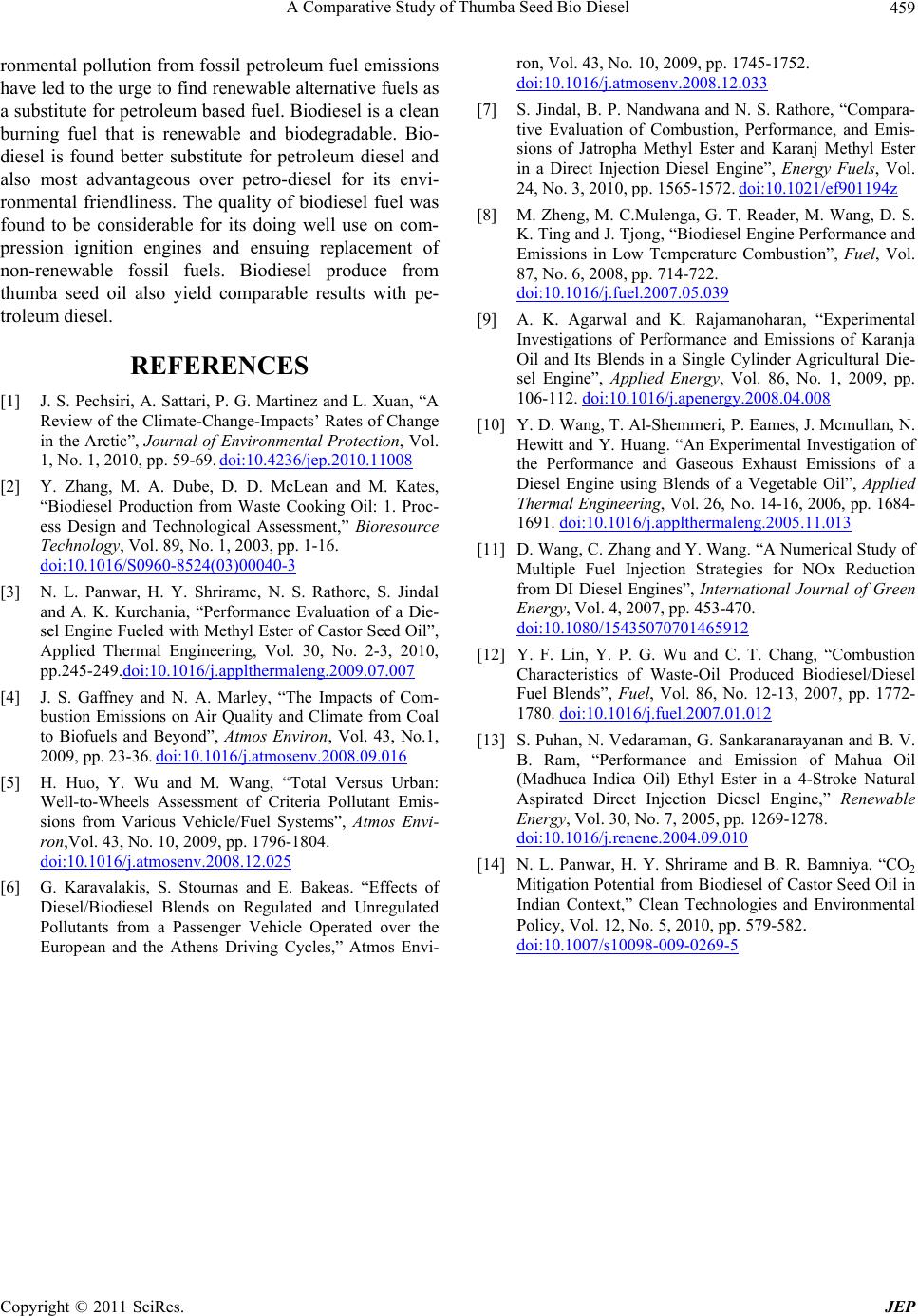
A Comparative Study of Thumba Seed Bio Diesel459
ronmental pollution from fossil petroleum fuel emissions
have led to the urge to find renewable alternative fuels as
a substitute for petroleu m based fuel. Biodiesel is a clean
burning fuel that is renewable and biodegradable. Bio-
diesel is found better substitute for petroleum diesel and
also most advantageous over petro-diesel for its envi-
ronmental friendliness. The quality of biodiesel fuel was
found to be considerable for its doing well use on com-
pression ignition engines and ensuing replacement of
non-renewable fossil fuels. Biodiesel produce from
thumba seed oil also yield comparable results with pe-
troleum diesel.
REFERENCES
[1] J. S. Pechsiri, A. Sattari, P. G. Martinez and L. Xuan, “A
Review of the Climate-Change-Impacts’ Rates of Change
in the Arctic”, Journal of Environmental Protection, Vol.
1, No. 1, 2010, pp. 59-69. doi:10.4236/jep.2010.11008
[2] Y. Zhang, M. A. Dube, D. D. McLean and M. Kates,
“Biodiesel Production from Waste Cooking Oil: 1. Proc-
ess Design and Technological Assessment,” Bioresource
Technology, Vol. 89, No. 1, 2003, pp. 1-16.
doi:10.1016/S0960-8524(03)00040-3
[3] N. L. Panwar, H. Y. Shrirame, N. S. Rathore, S. Jindal
and A. K. Kurchania, “Performance Evaluation of a Die-
sel Engine Fueled with Methyl Ester of Castor Seed Oil”,
Applied Thermal Engineering, Vol. 30, No. 2-3, 2010,
pp.245-249.doi:10.1016/j.applthermaleng.2009.07.007
[4] J. S. Gaffney and N. A. Marley, “The Impacts of Com-
bustion Emissions on Air Quality and Climate from Coal
to Biofuels and Beyond”, Atmos Environ, Vol. 43, No.1,
2009, pp. 23-36. doi:10.1016/j.atmosenv.2008.09.016
[5] H. Huo, Y. Wu and M. Wang, “Total Versus Urban:
Well-to-Wheels Assessment of Criteria Pollutant Emis-
sions from Various Vehicle/Fuel Systems”, Atmos Envi-
ron,Vol. 43, No. 10, 2009, pp. 1796-1804.
doi:10.1016/j.atmosenv.2008.12.025
[6] G. Karavalakis, S. Stournas and E. Bakeas. “Effects of
Diesel/Biodiesel Blends on Regulated and Unregulated
Pollutants from a Passenger Vehicle Operated over the
European and the Athens Driving Cycles,” Atmos Envi-
ron, Vol. 43, No. 10, 2009, pp. 1745-1752.
doi:10.1016/j.atmosenv.2008.12.033
[7] S. Jindal, B. P. Nandwana and N. S. Rathore, “Compara-
tive Evaluation of Combustion, Performance, and Emis-
sions of Jatropha Methyl Ester and Karanj Methyl Ester
in a Direct Injection Diesel Engine”, Energy Fuels, Vol.
24, No. 3, 2010, pp. 1565-1572. doi:10.1021/ef901194z
[8] M. Zheng, M. C.Mule nga, G. T. Reader, M. Wang, D. S.
K. Ting and J. Tjong, “Biodiesel Engine Performance and
Emissions in Low Temperature Combustion”, Fuel, Vol.
87, No. 6, 2008, pp. 714-722.
doi:10.1016/j.fuel.2007.05.039
[9] A. K. Agarwal and K. Rajamanoharan, “Experimental
Investigations of Performance and Emissions of Karanja
Oil and Its Blends in a Single Cylinder Agricultural Die-
sel Engine”, Applied Energy, Vol. 86, No. 1, 2009, pp.
106-112. doi:10.1016/j.apenergy.2008.04.008
[10] Y. D. Wang, T. Al-Shemmeri, P. Eame s, J. Mcmullan, N.
Hewitt and Y. Huang. “An Experimental Investigation of
the Performance and Gaseous Exhaust Emissions of a
Diesel Engine using Blends of a Vegetable Oil”, Applied
Thermal Engineering, Vol. 26, No. 14-16, 200 6, pp. 1684-
1691. doi:10.1016/j.applthermaleng.2005.11.013
[11] D. Wang, C. Zhang and Y. Wang. “A Numerical Study of
Multiple Fuel Injection Strategies for NOx Reduction
from DI Diesel Engines”, International Journal of Green
Energy, Vol. 4, 2007, pp. 453-470.
doi:10.1080/15435070701465912
[12] Y. F. Lin, Y. P. G. Wu and C. T. Chang, “Combustion
Characteristics of Waste-Oil Produced Biodiesel/Diesel
Fuel Blends”, Fuel, Vol. 86, No. 12-13, 2007, pp. 1772-
1780. doi:10.1016/j.fuel.2007.01.012
[13] S. Puhan, N. Vedaraman, G. Sankaranarayanan and B. V.
B. Ram, “Performance and Emission of Mahua Oil
(Madhuca Indica Oil) Ethyl Ester in a 4-Stroke Natural
Aspirated Direct Injection Diesel Engine,” Renewable
Energy, Vol. 30, No. 7, 2005, pp. 1269-1278.
doi:10.1016/j.renene.2004.09.010
[14] N. L. Panwar, H. Y. Shrirame and B. R. Bamniya. “CO2
Mitigation Potential from Biodiesel of Castor Seed Oil in
Indian Context,” Clean Technologies and Environmental
Policy, Vol. 12, No. 5, 2010, pp. 579-582.
doi:10.1007/s10098-009-0269-5
Copyright © 2011 SciRes. JEP